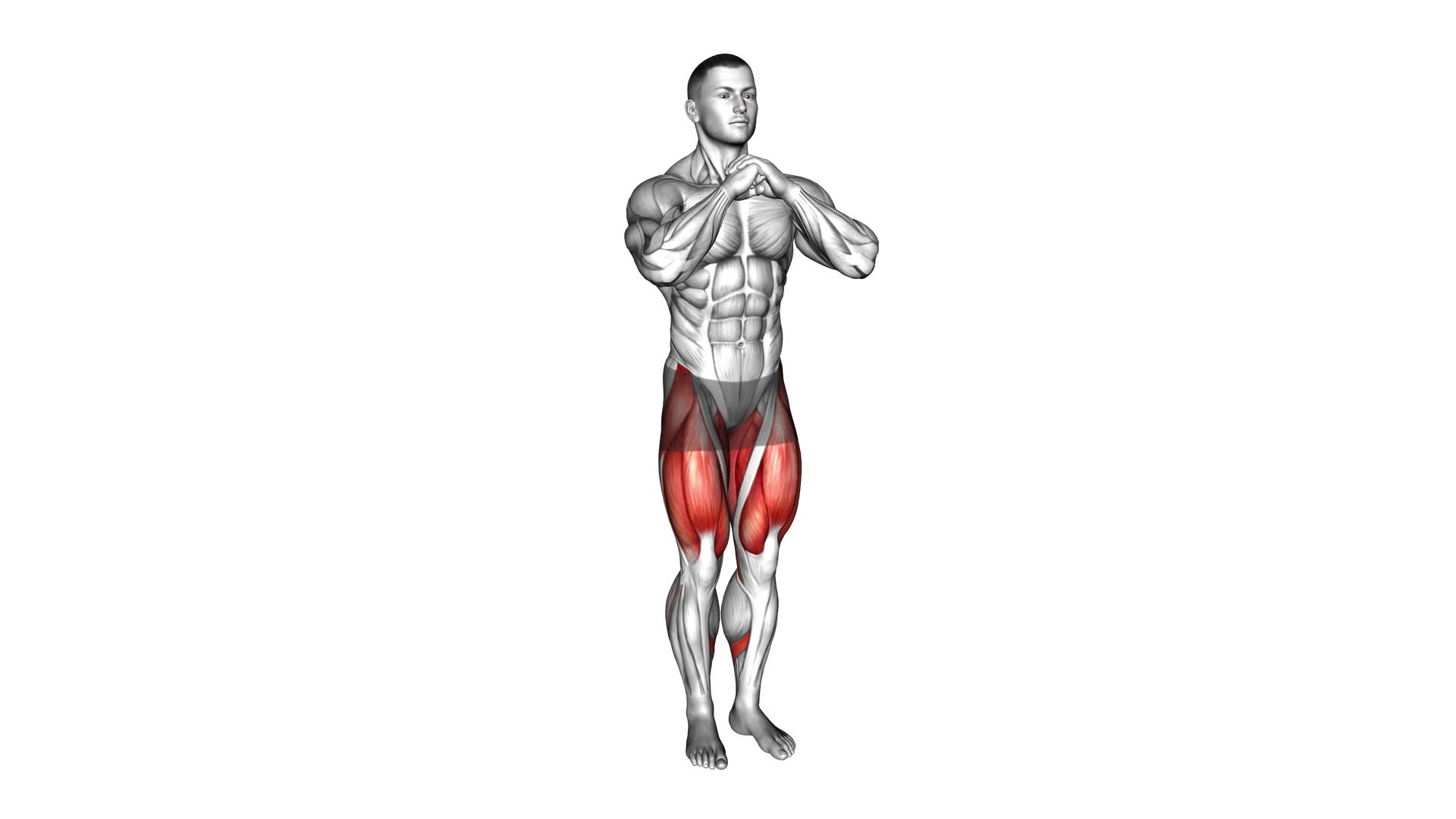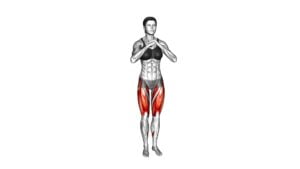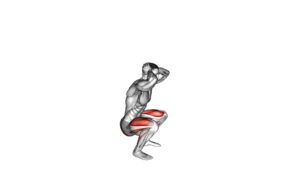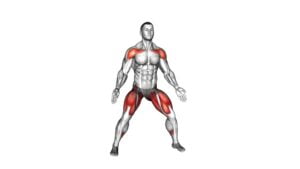Side Step Deep Squat (male) – Video Exercise Guide & Tips

Are you looking to strengthen your lower body and improve your squat technique?
Watch This Exercise Video
In this video exercise guide, we'll show you how to perform the side step deep squat with proper form and technique.
Avoid common mistakes and learn variations and modifications to suit your fitness level.
Increase the intensity of your workouts with helpful tips.
Get ready to take your squat game to the next level with this informative and concise guide.
Let's get started!
Key Takeaways
- The Side Step Deep Squat targets multiple muscles in the lower body including the quadriceps, hamstrings, glutes, and calves.
- It strengthens and tones the lower body, enhancing athletic performance and stability.
- The exercise improves flexibility in the hip adductors and abductors, and activates the core muscles for better posture and stability.
- Common mistakes to avoid include collapsing knees, rounding the back, neglecting the side step, and lack of depth in the squat. It is important to maintain proper form and engage the correct muscles.
Benefits of the Side Step Deep Squat
To maximize your workout, incorporating the Side Step Deep Squat into your routine offers a range of benefits.
This exercise primarily targets your quadriceps, hamstrings, glutes, and calves. By engaging these muscles, you can strengthen and tone your lower body, enhancing your overall athletic performance and stability.
Additionally, the Side Step Deep Squat helps improve flexibility in your hip adductors and abductors. These muscles play a crucial role in everyday movements, such as walking and running. By increasing their flexibility, you can reduce the risk of injuries and improve your range of motion in daily activities.
Furthermore, this exercise also activates your core muscles, including your abdominals and lower back. Strengthening these muscles can improve your posture and stability, allowing you to maintain proper form during other exercises and reduce the risk of lower back pain.
Proper Form and Technique
When performing the Side Step Deep Squat, it's important to maintain proper form and technique to ensure maximum effectiveness and minimize the risk of injury. Proper form not only helps in achieving the desired results but also prevents unnecessary strain on the muscles and joints.
To start, stand with your feet shoulder-width apart and toes slightly turned out. Then, take a side step to the right, keeping your back straight and chest lifted. Bend your knees and lower your body into a deep squat position, making sure your knees are in line with your toes.
Keep your weight in your heels and engage your core to maintain stability. As you come up, push through your heels and return to the starting position. Repeat the same steps on the left side.
Remember to breathe throughout the exercise and avoid any jerky movements. By maintaining proper form and technique, you can improve flexibility and prevent injuries while performing the Side Step Deep Squat.
Common Mistakes to Avoid
To avoid common mistakes while performing the Side Step Deep Squat, focus on maintaining proper alignment and engaging the correct muscles. Here are four common mistakes to avoid and tips for maintaining proper technique:
- Collapsing knees: Be mindful of your knee alignment throughout the movement. Avoid letting your knees cave inward by actively pushing them outwards and keeping them in line with your toes.
- Rounding the back: Maintain a neutral spine throughout the exercise to prevent excessive strain on the lower back. Engage your core muscles and keep your chest lifted to ensure proper alignment.
- Lack of depth: It's important to achieve a deep squat to fully engage the glutes and leg muscles. Aim to lower your hips until they're parallel to the ground or as close as possible, while maintaining proper form.
- Neglecting the side step: Don't forget to perform the side step in between squats. This lateral movement helps to activate the hip abductors and adds an additional challenge to the exercise.
Variations and Modifications
Continuing from avoiding common mistakes, you can modify or vary the Side Step Deep Squat exercise to add more challenge or accommodate different fitness levels.
There are several different squat variations that you can try to target different muscles and add variety to your workout routine. One variation is the Sumo Squat, where you stand with your feet wider than shoulder-width apart and turn your toes outwards. This targets your inner thighs and glutes more intensively.
Another variation is the Bulgarian Split Squat, where you place one foot on an elevated surface behind you and lower your body into a squat position. This variation helps to improve balance and stability while targeting the quadriceps and glutes.
If you're a beginner or have limited mobility, there are modifications you can make to the Side Step Deep Squat to make it more accessible. One modification is to reduce the depth of the squat by not lowering yourself as far down. This will still engage your muscles while putting less strain on your joints.
Another modification is to hold onto a stable surface like a chair or wall for support. This will help with balance and stability, allowing you to focus on the proper form of the exercise.
By incorporating different squat variations and modifications for beginners, you can customize the Side Step Deep Squat exercise to suit your individual needs and goals.
Now, let's move on to the next section where you'll learn some tips for increasing the intensity of this exercise.
Tips for Increasing Intensity
To further challenge yourself and increase the intensity of the Side Step Deep Squat exercise, you can incorporate these tips:
- Increasing Resistance: One of the most effective ways to intensify this exercise is by adding resistance. You can use resistance bands around your thighs or hold a dumbbell or kettlebell in front of your chest. This will engage your muscles even more and help you build strength.
- Advanced Modifications: If you're looking for a more advanced version of the Side Step Deep Squat, you can try a few modifications. One option is to perform the exercise on an unstable surface, such as a Bosu ball or balance board. This will challenge your stability and activate your core muscles. Another modification is to add a jump at the end of each squat, increasing the explosive power required.
- Tempo Variations: Changing the tempo of your squats can also increase the intensity. Try slowing down the lowering phase of the squat and then exploding up quickly. This will work your muscles in a different way and make the exercise more challenging.
- Increase Range of Motion: To further challenge yourself, try performing the Side Step Deep Squat with a wider stance. This will increase the range of motion and target different muscles, particularly your glutes and inner thighs.
Incorporating these tips will help you take your Side Step Deep Squat exercise to the next level, pushing your limits and achieving greater results. Remember to listen to your body and progress at your own pace.
Sample Workout Routine
To create an effective workout routine, you need to consider the combination of exercises, the duration of each exercise, and the recommended rest intervals.
A well-rounded workout should include a mix of strength training, cardio, and flexibility exercises. It's important to vary the intensity and duration of each exercise to challenge your body and prevent plateauing.
Additionally, incorporating rest intervals allows your muscles to recover and prevents overexertion.
Effective Workout Combinations
Achieve maximum results by incorporating effective workout combinations into your sample workout routine. Here are four workout combinations that can help you optimize your fitness journey:
- Superset: Pairing two exercises that target different muscle groups back-to-back without resting in between sets. This increases the intensity and efficiency of your workout.
- Circuit Training: Performing a series of exercises consecutively with minimal rest in between. This helps to improve cardiovascular endurance and burn calories.
- Drop Sets: Starting with a heavier weight and gradually decreasing the weight as you fatigue. This technique helps to push your muscles to their limits and promote muscle growth.
- Pyramid Sets: Starting with light weights and gradually increasing the weight as you progress through each set. This allows you to focus on both muscular endurance and strength.
By incorporating these effective workout combinations, you can optimize your workout routine and achieve your fitness goals.
Now, let's move on to the next section and discuss the duration of each exercise.
Duration of Each Exercise
Now let's focus on the duration of each exercise in your sample workout routine.
When it comes to warm-up exercises, it's important to allocate an appropriate amount of time for stretching. The duration of warm-up exercises can vary depending on your fitness level and the intensity of your workout. Generally, it's recommended to spend at least 5-10 minutes on stretching to prepare your muscles for the upcoming exercises. Stretching helps increase flexibility, reduce the risk of injuries, and improve overall performance. Remember to hold each stretch for 15-30 seconds and repeat it 2-3 times.
Recommended Rest Intervals?
Once you have completed your warm-up exercises, it's important to consider the recommended rest intervals for your sample workout routine. Proper rest periods are crucial for allowing your body to recover and maximize the benefits of your workout.
Here are four key points to keep in mind when determining your rest periods:
- Exercise intensity: The higher the intensity of your exercise, the longer your rest periods should be. High-intensity exercises require more recovery time to allow your muscles to replenish energy and reduce fatigue.
- Exercise duration: Longer workouts generally require longer rest periods. If you're performing exercises that last for several minutes, you may need to extend your recovery time to ensure you're fully rested before the next set.
- Muscle group focus: If you're targeting a specific muscle group, it's essential to allow enough recovery time for those muscles before engaging them again. This helps prevent overuse injuries and promotes muscle growth.
- Individual fitness level: Rest periods can vary depending on your fitness level. Beginners may require longer recovery time compared to more experienced individuals. Listen to your body and adjust your rest intervals accordingly.
Frequently Asked Questions
How Many Calories Does the Side Step Deep Squat Burn?
When you perform the side step deep squat, you're not only working on improving your balance, but also burning calories. The exact number of calories burned during this exercise can vary based on factors such as your weight and intensity level.
To make the most out of it, you can try different variations of the side step deep squat, such as adding weights or increasing the tempo. These variations can help you increase the calorie burn and challenge your muscles even more.
Can the Side Step Deep Squat Help Improve Flexibility?
The Side Step Deep Squat is a great exercise for improving flexibility. By incorporating this movement into your routine, you can increase your range of motion and enhance your overall flexibility.
Not only does it target your lower body muscles, but it also helps in improving balance. Adding this exercise to your workout regimen can provide numerous benefits for your body, helping you become more flexible and agile.
Is It Safe to Perform the Side Step Deep Squat if I Have Knee Pain?
If you have knee pain, it may not be safe for you to perform the side step deep squat. It's important to listen to your body and not push through the pain.
There are modifications you can make to the exercise to reduce strain on your knees, such as keeping your feet closer together or using a chair for support.
Alternatively, you can try alternative exercises like lunges or step-ups, which are less stressful on the knees.
Can the Side Step Deep Squat Help Build Muscle in the Lower Body?
The side step deep squat is a great exercise for building muscle in your lower body. It targets your glutes, quads, and hamstrings, helping to strengthen and tone these muscles.
In addition to muscle growth, this exercise also improves overall fitness by increasing lower body strength and stability.
To add more challenge, you can try variations like holding dumbbells or adding a jump at the end of each squat. These variations will further engage your muscles and enhance the benefits of the exercise.
How Often Should I Include the Side Step Deep Squat in My Workout Routine for Best Results?
For optimal results, include the side step deep squat in your workout routine regularly. This exercise is great for building lower body muscle and improving overall strength. Aim to perform it at least 2-3 times per week.
To see even better results, consider incorporating variations and progressions of the side step deep squat into your routine. This can help challenge your muscles in different ways and prevent plateaus.
Remember to always maintain proper form and listen to your body to avoid injury.
Conclusion
In conclusion, the side step deep squat is an effective exercise for strengthening the lower body and improving balance. By following proper form and technique, you can reap the benefits of this exercise and avoid common mistakes.
Additionally, variations and modifications can be made to suit your fitness level and increase the intensity. Incorporating the side step deep squat into your workout routine can help you achieve your fitness goals.

Author
Years ago, the spark of my life’s passion ignited in my mind the moment I stepped into the local gym for the first time. The inaugural bead of perspiration, the initial endeavor, the very first surge of endorphins, and a sense of pride that washed over me post-workout marked the beginning of my deep-seated interest in strength sports, fitness, and sports nutrition. This very curiosity blossomed rapidly into a profound fascination, propelling me to earn a Master’s degree in Physical Education from the Academy of Physical Education in Krakow, followed by a Sports Manager diploma from the Jagiellonian University. My journey of growth led me to gain more specialized qualifications, such as being a certified personal trainer with a focus on sports dietetics, a lifeguard, and an instructor for wellness and corrective gymnastics. Theoretical knowledge paired seamlessly with practical experience, reinforcing my belief that the transformation of individuals under my guidance was also a reflection of my personal growth. This belief holds true even today. Each day, I strive to push the boundaries and explore new realms. These realms gently elevate me to greater heights. The unique combination of passion for my field and the continuous quest for growth fuels my drive to break new ground.







